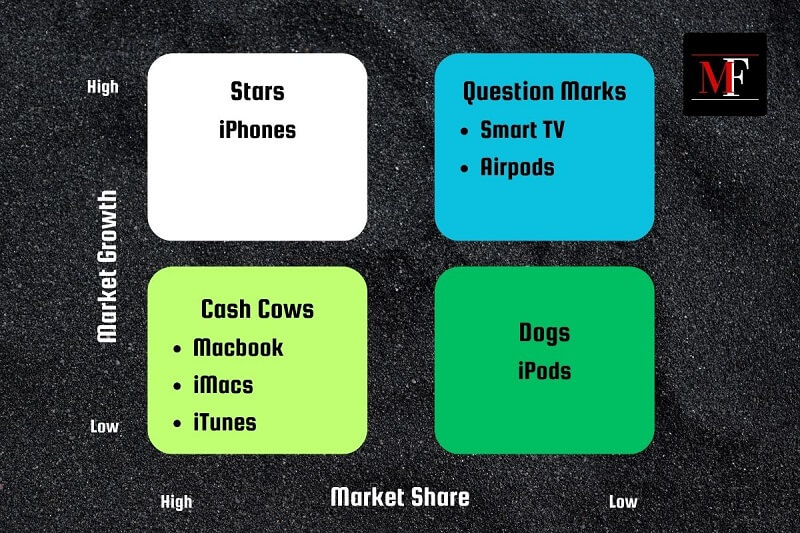Businesses often evaluate their products and services to see how well they are doing. One popular method for the evaluation is using the BCG matrix, which helps analyze products based on market growth and share.
BCG matrix helps businesses decide where to put their resources and plan their future strategies. Developed by the Boston Consulting Group in the 1970s, the BCG matrix examines a brand’s products based on market growth and share.
In this article, we will take a look at BCG matrix of Apple to see which products are growing well and which ones have lower market shares. Let’s start with a brief introduction of Apple company.
Apple Inc. Background
Apple is a prominent leader in the smartphone and computer manufacturing industry worldwide. Founded in 1976 by Steve Wozniak, Ronald Wayne, and the late Steve Jobs, the company officially became Apple Computer, Inc. in the following year.
After going public in 1980, it quickly grew to become the world’s most valuable company, currently with a market capitalization of $2.927 trillion. Although Apple computers still generate significant revenue, the brand’s main focus and prominence in today’s market are primarily attributed to its iconic iPhones.
BCG Matrix Analysis of Apple
BCG matrix of Apple Inc. assesses the products within its brand portfolio and categorizes them according to their performance regarding market growth rate and current market share. Here is BCG matrix diagram of Apple Inc.

1. Stars
In the BCG matrix, stars represent products with both a high market share and significant potential for further growth. For Apple, the iPhones stand out as the stars in their product mix. iphones have consistently been the top choice for consumers globally, continually breaking sales records with each new release.
2. Question Mark
Questions marks in the BCG matrix are products with high potential for growth but currently have low market share. Smart TVs, newly introduced by Apple, currently hold a modest market share but possess significant growth opportunities.
With effective marketing and issue resolution, they have the potential to replicate the success of the iPhone and become stars. Positioned strategically within Apple’s product range, Smart TVs represent untapped potential in a flourishing market.
By incorporating consumer feedback to refine and enhance their offerings, they could evolve from question marks to dominant market players, just like iPhones.
3. Cash Cows
Cash cows are products possessing substantial market share within a stagnant market environment. Essentially, they are the dependable, high-profit generators for a company. In Apple’s context, cash cows include the MacBook, iTunes, and iMacs.
Despite the emergence of competing products, these cash cows have maintained their dominance in the market. That is mainly because of unwavering loyalty of Apple’s customer base built over time.
4. Dogs
Dogs represent products with inherent quality but face challenges in generating significant revenue due to stagnant market growth. When analyzing Apple’s BCG matrix, iPods serve as a prime example of such products.
Although they were once a dominant force, their popularity decreased with the rise of competing alternatives. This decline in demand has led to decreased profitability that may even put Apple at risk of losses.
While the iPods have a rich history, their diminishing relevance truly shows the fierce competition in the tech industry and emphasizes Apple’s continuous adaptation to changing consumer preferences.
You can also read Nestle’s BCG matrix analysis.
Summing it up
Apple, a global giant, offers a diverse product range from computers to smart phones to digital tablets and music streaming. BCG matrix of Apple categorizes Apple’s main products based on market share and growth.
However, the analysis has its limitations as its focus solely on market share and growth, overlooking other factors influencing product performance.
